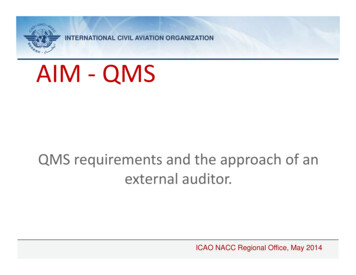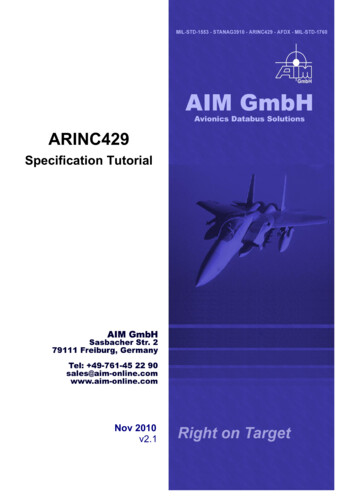
Transcription
Why & How to Aim Headlamps and AuxiliaryLampsNo matter how good (or bad) your headlamps and fog lamps might be,they'll work effectively and safely only if they're correctly aimed. Lampaim is by far the main thing that determines how well you can (or can't)see at night—it's even more important than the output and beampattern of the headlamps themselves. Here's a real example of howcrucial it is: if you're using the shine-on-a-wall method, aiming aparticular kind of low beam just 2.3 cm (0.9 inch) lower than it shouldbe cuts 26 m (85 feet) off your seeing distance at night!But in North America most people don't know or care much about lampaim, figuring—very incorrectly—that if they're not getting flashed atnight the lamps are OK. Most states and provinces long ago stoppedrequiring periodic aim checks. The few remaining areas mostly use anunreasonably sloppy go/no-go standard that can only catch vehicles withlights pointing down on the bumper or up in the trees.U.S. and Canadian Federal law doesn't require new vehicles to comewith the lamps correctly aimed, so even a brand-new car doesn'tnecessarily have the lights pointing where they should. It's such aproblem that the Insurance Institute for Highway Safety checks, butdoesn't adjust the aim of the headlamps on cars they test. They do itthis way because most new cars don't get the aim corrected beforedelivery, and since poor aim worsens the headlight performance rating,this test-as-received policy of IIHS is an effort to push automakers anddealers to do a better job.So "close enough" really isn't good enough; make the effort to get thelamps aimed carefully and correctly, very preferably with an opticalaiming machine. That's a device that looks a bit like a TV camera. Itgets wheeled in front of each headlamp on your vehicle, adjusted toheight, and the optics within the machine permit highly precise visualaim checking and adjustment—definitely the most accurate way to aimlamps. To get an idea of what a proper lamp aim job looks like (on anymake or model of vehicle), see this VW document.
It can be difficult to find a shop that has one. And even dealerships thathave one often don't bother using it; if a customer comes in andcomplains about the lights, they get randomly raised (if the complaint is"can't see") or lowered (if it's "getting flashed"). Keep calling arounduntil you get the right answer. "We shine them on a wall/on a screen" or"Yeah, we can try and level 'em out for you" or "The headlamps on thatvehicle aren't adjustable" are examples of wrong answers. Really beatthe bushes before deciding nobody near you has one; ask at high-endbody shops and auto dealer service departments, but if you have noluck, try talking with the companies who make the aiming machines.They should be able to tell you who has their machines in your area.Check with American Aimers and Lujan-Sniper. Call Hella USA at 1877-22HELLA (1-877-224-3552) and ask who has a HellaBeamsetter.If you just cannot find someone who has an optical aiming machine andis willing to use it correctly, you will have to make do with the distantsecond-preference method of putting the vehicle on flat, level groundand shining the lamps on a wall a certain distance away. It has to bedone as carefully and precisely as possible, so here are detailedinstructions:Find a location that has a vertical wall and enough flat, level ground forthe length of the vehicle plus 7.6 m (25 feet). This is surely the hardestpart of the whole procedure; it's not common to find really, truly flat,level ground that long. Do the best you can.To prepare for aiming, the car should have about half a tank of fuel,weight in the trunk and passenger compartment equal to the mostfrequently carried load (this may be a full trunk, or it may be an emptyone, or anything in between), and weight in the driver's seat equivalentto the most frequent driver. All of the tires should be checked when coldto make sure they're at the correct inflation pressure. Jounce eachcorner of the car firmly (grasp the bumper and push down several timesrhythmically) to ensure that the suspension is settled into a normalposition.The wall will be used as an aiming screen, so it should be of a lightcolour. You'll need to make marks on it, so if it is a wall you're notallowed to deface, use removable tape. Pick a dark or bright colour thatwill contrast with the light wall so you can see the marks clearly from adistance. Measure 7.6 m (25 feet) straight back from the wall, and markthis position on the floor or ground. Align the front of the vehicle withthis floor mark, and then bring the vehicle straight forward, right up tothe wall. If you're working on a motorcycle it will have to be heldupright and steered straight ahead, so you might want a helper. Make amark V on the wall directly in front of the centre of the vehicle. Good
references for the centre point include such things as hood ornaments,grille badges and license plate brackets. It can sometimes be helpful togo behind the car and sight through the backglass and windshield.Next, make a mark C on the wall directly in front of the axis of eachlamp. The lamp axis is often marked with a dot, cross, bulb typedesignation or name brand, but if not, it is directly in front of the bulb.There is one axis for each lamp, so a vehicle with four lights will havefour axes and a vehicle with two lights will have two, plus any auxiliaryfog and/or driving lamps that may be present.Now, move the vehicle straight back from the wall until the headlampsare above the floor mark. Walk to the wall and make additional marks:Extend the V mark with a vertical line downward at least 15 cm (6inches). Next, connect all of the C marks with a horizontal line we'll callH-H. Then, measure downward—this measurement is represented inturquoise here—from each C mark that represents the axis of a lampthat produces a low beam or a fog beam (no need to do this for lampsthat produce only a high beam) per the following tables:U.N. (ECE, European, "E-Code") lampsandU.S. ("DOT", "SAE") lamps marked VOLUp to 34.5" (80 cm)2.1" (53 mm)35" to 39" (89-99 cm)2.5" (64 mm)39.5" or higher (100 cm)3" (76 mm)U.S. ("DOT", "SAE") lamps marked VORandolder U.S. lamps without a "VOL", "VOR", or "VO" markUp to 34.5" (80 cm)N/A, do not measure downward35" to 39" (89-99 cm)2" (50 mm)39.5" or higher (100 cm)3" (76 mm)All lamps producing only high beamandDriving (auxiliary high beam) lampsAny mount height (80cm)N/A, do not measure downwardFog lamps
Up to 18" (46 cm)1.5" (38 mm)18.5" to 28" (47-71 cm)3" (76 mm)28.5" or higher (72 cm)4" (102 mm)Connect these two newly-measured points with a horizontal line we'llcall B-B, represented here in red. After you've done all of this, yourwall will be marked like this for a system of two high/low beamheadlamps (or for a pair of fog lamps):Or like this for a system of two low- or low/high beam plus two highbeam lamps:Notes for the table and figures shown so far:
The visual aim procedure for lamps listed above as "N/A, do notmeasure downward" does not require the lower B-B horizontalline; just connect your C marks with a horizontal H-H line.The 4-lamp diagram shown here is drawn for two lamps on eachside of the car arranged side by side. If your vehicle has twolamps on each side stacked atop each other, canted, or otherwisearranged, your marks for the high beams—represented here bythe blue dots—will follow that arrangement.U.S. ("DOT", "SAE") headlamps designed before 1998 won't havea "VOL", "VOR", or "VO" marking. Instead they'll have either threesmall cones on the front of the lens in a triangular pattern, or asmall spirit bubble level built into the top of the headlamphousing, visible with the hood raised.Now draw a vertical line through through the centre of each C point. Dothe same with the V point. These lines make it easier to see thereference marks when you are standing 25 feet away, adjusting theaiming screws on the car. You now have an accurate plot on the wall ofthe height and separation of the headlamps (if your car is level, theground is level, and the wall is vertical). Note that the "B-B", "C" and "V"designations are for purposes of clarity in this descriptive article. It isnot necessary to draw the letters on the wall—just plot the points. Ofcourse, you may use the letters in your aiming procedure if it will helpyou.Low Beams: Vertical AimingImportant note: These instructions are written for countries with righthand traffic (vehicles flow on the right side of the road). To use them incountries with left-hand traffic, such as the U.K., Australia, and Japan,read "left" for "right" and vice versa.The low beam pattern of a visually-aimable headlamp has a distincthorizontal "cutoff" at the top of the beam pattern. It may be hard/razorsharp, or it may be softer/fuzzier. Below the cutoff is bright light, andabove is dark. Vertical aim is done by measuring and adjusting theheight of this cutoff relative to the reference marks you put on the wall.For U.N. (ECE, European, "E-code") and U.S. VOL headlamps, the cutoffto pay attention to is at the top of the left half of the beam pattern, andit should be aligned with the B-B line.U.S. (DOT, SAE) VOR headlamps can have a straight-across cutoff lineextending all the way across the top of the low beam, or a stairstepshaped cutoff that's lower on the left and higher on the right side of thebeam, or just a squared-off top edge of the high-intensity "hot spot"(brightest part of the beam). Whichever style it is, the cutoff to payattention to is at the top of the right half of the beam pattern. It shouldbe aligned with the applicable horizontal line per the table above.
Motorcycle headlamps often have a straight-across cutoff line at thetop of the low beam; they get aimed this same way (again, you'll need ahelper or other means of holding the bike upright and steered straightahead). A low beam with a flat-across cutoff gets aimed like this:For older U.S. headlamps, the ones with the three lens bumps or thespirit level, you will have to do your best to place the top edge of the lowbeam's high-intensity "hot spot" on the applicable horizontal line per thetable above.Low Beams: Horizontal AimingThe technical specifications for U.S. (DOT, SAE) VOL, VOR, and VOheadlamps are such that in most cases these lamps cannot be aimedhorizontally; no provision for horizontal aim adjustment is provided.American regulators writing the rules in the mid-1990s declared there isno way "without damaging the beam pattern" to define a visual cue,such as a kink in the cutoff, to allow for accurate horizontal placement ofa headlight beam. They did not comment at that time on the fact thatcars get in fender-benders that knock the headlamps out of horizontalalignment, but they did say the low beam patterns they were definingwere wide enough that horizontal aim wouldn't really matter. Time—andscrutiny by the likes of IIHS and Consumer Reports—have not borne thisout. Notably, the European beam pattern introduced in 1956 (and still inuse) was designed to allow for horizontal and vertical aimability, andthat's been working fine for over six decades now. And even in NorthAmerica, there are plenty of situations where horizontal aim can andshould be checked and corrected. Vehicles that have had a different-
than-original type of headlamp installed, for example.U.N. (European, ECE, "E-code") and VOL headlamps have one or twokinks in the cutoff line. If there's just one kink, it's where the cutoffbends upward from horizontal. If there are two kinks, the cutoff line willlook like a stairstep.For the kind of cutoff line with a single kink, adjust each headlamp sothat its kink lines up (left to right) with the C mark, then adjust thehorizontal aim slightly leftward so the angled, ramp-shaped part of thecutoff line aproaches your C mark. It's best if the angled/ramp part ofthe cutoff line just barely touches the C mark; this slight leftward nudgeof the aim increases seeing distance down the road relative to Europeanpractice, but don't overdo it; excessive leftward aim will result inexcessive glare to oncoming traffic, and it will pull the high beams out ofoptimal alignment. The beam, with correct vertical and horizontal aim,should look like this:For the kind of cutoff line with two kinks forming a stairstep, adjust theupper kink so it lines up (left to right) with the C mark in front of theheadlamp you're adjusting. By placing the upper rather than lower kinkin line with the C mark, you will obtain optimal seeing distance withoutcreating other problems. The beam, correctly aimed vertically andhorizontally, should look like this:
For older U.S. headlamps, the ones with the three lens bumps or thespirit level, you will have to do your best to place the left edge of the lowbeam "hot spot" on (or slightly overlapping) the vertical line extendingdown from the C mark in front of the lamp you're aiming, so thecorrectly-aimed beam (vertically and horizontally) looks like this:The Volkswagen PDF linked near the top of this page contains moreimages of various low beam patterns; study it to get an idea of whatyou're looking for.After adjusting a high/low beam headlamp on low beam, do not attemptto readjust it on high beam. All high/low beam headlamps are meant tobe adjusted on the low beam setting only; the high beam adjustment iscorrect when the low beam adjustment is correct. If you are
experiencing a problem where setting the low beams correctly places thehigh beams too high, but setting the high beams correctly places the lowbeams too low, you are dealing with a faulty or poorly-designedheadlamp.Driving Lamps and High-Beam-Only Headlamps In 4-LampSystemsThese instructions apply to headlamps that produce only a high beam,and to all "driving" (auxiliary high beam) lamps. These must be adjustedso that the bright, central "hot spot" of the beam is straight ahead of thelamp in both the vertical and horizontal planes. Pay attention to t
small cones on the front of the lens in a triangular pattern, or a small spirit bubble level built into the top of the headlamp housing, visible with the hood raised. Now draw a vertical line through through the centre of each C point. Do the same with the V point. These lines make it easier to see the reference marks when you are standing 25 feet away, adjusting the aiming screws on the car .











